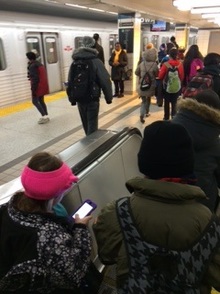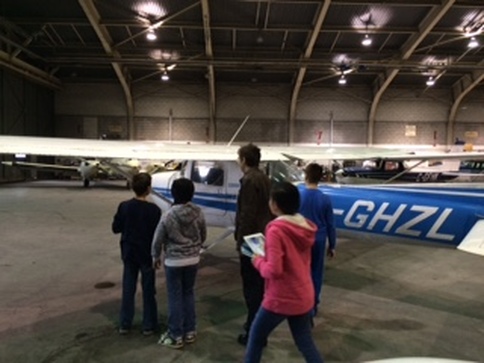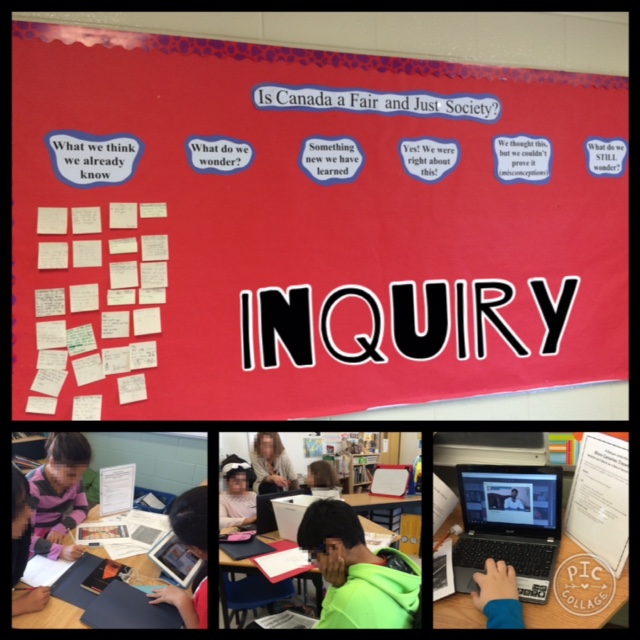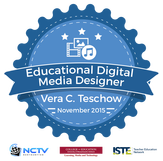Yesterday we braved the at-times thigh-deep snow drifts, and made it to the beach without snowshoes!
|
PEI in winter can be a cold, desolate place. But its stark contrast to summer only increases the allure of the north shore's ever-changing landscapes. Yesterday we braved the at-times thigh-deep snow drifts, and made it to the beach without snowshoes!
0 Comments
There is nothing quite so awful as a parent of school-aged-children, as having to work together with your child on a homework assignment. Especially an assignment for which the criteria are completely unclear. Over the holidays, one of my children has the task of preparing an oral presentation which he will be presenting to his class, along with a ppt slide deck, and the boy had asked me for help in creating cue cards to help with his talk. The presentation is an extension of a multi-paragraph movie critique he wrote some weeks ago, and while a fairly extensive rubric (ugh, who still uses those?!) was provided for said written assignment, precious little seems to have come forth for the ppt and oral components of the assignment. Asking the child for the criteria yielded a stubborn reply at best. It was baffling to him why I would inquire about such a thing. I explained that knowing the end goal might be helpful as we worked towards preparing an effective presentation. Knowing what was expected of him, and how his assignment would be marked, would help him/us to work towards a product that he could be confident in. I was particularly troubled by the fact that the child seemed intent on basically reading aloud each text-enveloped slide to his audience, and I was hoping that some teacher-provided guidance might yield fodder for a conversation about how the ppt would better be used as a visual backdrop or enhancement rather than a wall of text with which to overwhelm his classmates. My outrageous request resulted in tears and drama, as the dear boy insisted everything was fine as is, and he just needed my help transferring the mass to index cards which he would use while presenting. (He was not interested in my suggestion that the cue cards could contain jot notes from the presentation, either. It was to be the text in its entirety, copied out copiously onto a million small index cards!) The entire ordeal was an exercise in frustration (and one that is not over yet; we got about a quarter of the way through his presentation before calling it a night). As I lay on my bed recovering, now myself fighting back tears as I agonized over what a terrible mother I clearly was, a small voice inside me spoke the wise words of Thelma Jarvis, my first principal and long-time mentor: "What's good about this situation?" she whispered deep inside my mind, reminding me of her tireless drive towards positive action in real life. So, determined to find the silver lining, the teacher in me searched for classroom connections. As I faced the reality that many of my own students could use a little guided instruction in how to prepare an effective slide deck, a lesson plan began to take shape inside my brain: I would use two versions of my child's ppt presentation -- the text-laden one, and a more visual-cues-style presentation -- to share with my class and engage them in a critical thinking lesson. In a few weeks, as we finish up a Social Studies inquiry we started earlier in December, my Grade sixes will be presenting their findings and supported opinion about a big idea they have explored. Their presentation will include both an oral and a visual media component. In preparation for said presentation, I will ask them to assess which of my child's two movie critique presentations is more effective and why. Then we'll co-construct some success criteria, which I shall post in class and online for them to refer to as they proceed with preparing their own presentations. I am hopeful that in completing this exercise with my students, I can help them to avoid some of the pitfalls that my own son fell into. I am also hoping that doing this will help model effective application for my own child, with whom I intend to share this lesson (ugh, the trials of being a teacher's kid!!)
And I hope to inspire those teachers who are not yet using co-constructed and descriptive feedback to begin experimenting with this method so that they can let go of the rubrics that few if any students ever read, and move into a more effective and research-based form of assessment. Clarifying expectations on assignments through the use of co-constructed criteria helps students know what they need to do. It helps teachers with marking. And, most importantly to me right now, setting and providing clear criteria at school helps families avoid tears and drama at home. What better way to unload a bunch of holiday junk than take it to the Skittles pop-up shop on Queen?! A temporary "pawnshop" of sorts, this marketing endeavor by Wrigley accepts your gifts and other stuff and pays you in Skittles! A charming deal-maker comes out, appraises your items, and makes you an offer you can't refuse. The items are then donated to Goodwill, and you walk away with a giant load of sugar. For our treasures, which consisted of two new toys, still in the box, several gently used books, a picture snow globe with generic family and a "mystery gift" (which I suspect was a collection of bath products), we received no less than 72 packs of the tangy, chewy candy.
That's two full cases! Needless to say, my head is swimming with possibilities for "math eyes" problems… Probability, fractions, etc. But the boys were having none of it – – they intend to take one case of skittles to PEI with them to share it with our neighbors there, and keep another to share with friends at school next week, after the holidays.
So I am finally catching up on a bunch of overdue assignments from an online course I am taking -- this week we were supposed to "tell our story", digitally, about our experiences with Edmodo, and what benefits (for students and teachers) we have observed.
I decided to combine two new apps I am learning to use with my students this year: Thinglink and Vocaroo. Of course, this is just a snapshot, but I like the result, and will experiment more with these two apps combined, to see how students might use them to demonstrate their understanding and communicate what we are learning together in class and online. I figure, hey, if Ms. Teschow can learn how to do it, then so can my students!! :-) 
Next and final stop for this course: Screencasting. I'm a little overwhelmed, but cautiously optimistic in my ability to figure it out. And then... a few days on PEI with Tats and the boys, to just -- RELAX!!! I knew that in theory getting kids interested in something results in higher achievement. I may have even glimpsed it in practice a few times, for example when I "Tony Stead-i-fied" my classroom library a few years ago, and sat back in amazement as hitherto reluctant readers began to engage in reading eagerly and often... but it's been a while where the link between student buy-in and the work they produce has hit me so squarely in the face as it did yesterday... In lieu of the horrible holiday movie and festive party that invariably results in mayhem and leaves a classroom strewn with wrappers, empty drink bottles and general mess in its wake on the last day of school before winter holidays, I opted instead to take my students from Mississauga to Toronto by public transit. Prepared as I was for their pre-trip excitement and a fun day on the road in small groups (we had subdivided into 4 groups of 5-7 students plus one adult), I was not prepared for the content the students would spontaneously produce while engaged in the field trip. It was true that I'd had them plan the trip themselves, everything from finding the most efficient route, to calculating mileage and average speed per km while in transit, to finding fun and free activities to do while in Toronto. So to say they were invested would be an understatement (one student had even researched helmet laws in Toronto and rental fees at Nathan Phillips Square, so that a few of them could go skating -- it's $5 per helmet, and $5 per 2-hour skate rental, btw).  getting onto the Yonge line getting onto the Yonge line What amazed me, though, was the amount of self-directed effort students were putting into completing both their pre-trip assignments, as well as their "on the go" work. While some took endless selfies, others pointed out street musicians and urban art as I had requested, and still others noticed and commented on a variety of observations (why the other subway cars on the Yonge line look like they're turning when you're going around a curve in the tracks, while the one you're sitting in always seems to be straight, for example!) One student -- a child who barely writes two sentences in class without constant redirection -- self-selected to blog as she went along. Screens and screens of text she wrote: Everything from impressions of the bus and subway, to sights, smells and sounds on the streets of Toronto. She wrote and wrote and wrote, until her device ran out of battery. Another student gave some coins from his pocket to two of the many homeless people we observed while in the city, explaining to me that he was fulfilling his duty under the Muslim pillar of Zakah. (He ran out of money before Toronto's streets ran out of a supply of homeless for him.) A lively conversation ensued, about the religious and secular responsibilities to look after one another as members of society, who was responsible (government vs. people), and what that might entail in different contexts. When the class dispersed to check out Chinatown or visit another activity they had pre-selected after visting the Christmas windows, my small group hopped back onto the subway and headed down to Union station to catch the shuttle to the Island Airport. Students were extremely engaged, as we had recently read a debate about this very airport in our literacy textbook at school, and had looked at photos of some of the homes on the island in class. They also had a million questions about the underground tunnel (oh how I wished I'd had this infographic at the time!!), and more generally, about the concept of an island so close to the city. We'd also just finished our study of flight in Science, so when we arrived at the small flight school next to the Porter terminal and were offered a tour of the hangar by Ms. Kachira, who happened to be working that day, the students were quite excited to participate, marveling at being able to name some of the airplane parts they had memorized from a diagram in real life now. As one student remarked, as he looked at an actual airfoil (wing) up close, "Oh, now I get it!" Each student also had a chance to sit and be photographed in the cockpit, which they enjoyed a great deal, and which I immediately posted to parent accounts on Edmodo. Almost before I could post the suggested "After" assignments for the field trip when I got home, the student-initiated content started appearing on Edmodo: "Best trip ever!" noted one student, who accompanied his post with several selfies and group photos from the trip.
"We saw...." followed by a long, descriptive string of paragraphs from a student in a different group. Questions and responses amongst the groups ensued, focused in ways I have rarely experienced in class!! They were genuinely interested in hearing about one another's adventures, and learning from their divergent experiences of the city. The blossoming self-confidence I had observed earlier in the day, as this group of loosely-monitored 11-year-olds navigated public transit (many of them riding subways and public buses for the first time in their lives!), was evident in their writing, and I am looking forward to using their self-initiated work when we return to school in January, and building on it to develop and refine their writing and media skills. The world is a big, exciting place. Bigger and more exciting by far than worksheets and textbooks. Following students' leads, and building on to their existing strengths and interests, can help educators foster a growing understanding of the world for their students and encourage them to demonstrate their understanding of said world in a more inspired, pain-free manner! On Friday, December 18th, in an attempt to build schema and a desperate effort to evade the inevitable "last day before the holidays" chaos in class, a few colleagues and I are taking my Grade 6 students to Toronto for the day. An extension of our Language, Math, Science, Social Studies and Art programs, we will be traveling by public transit to check out the Holiday Display Windows at the Bay's flagship store at the corner of Yonge and Queen Streets. Time permitting, we may also visit some other nearby attractions. As part of their Math, Reading and Social Studies mark, students were asked to plan the trip and submit said plans before we went. These plans included using planning apps and sites like Triplinx, deciding what else was free and accessible, and where one might stop for lunch!
DURING I also cooked up a few things to do while we are out and about in Toronto on the 18th. The work they do during the trip will help students with their "After" assignments (see further down). These activities are easily adaptable to any urban field trip:
AFTER
Once we return from our field trip to Toronto, we will be heading into two weeks of winter break. But I plan to give students time upon returning to school to debrief the trip and reflect on what they saw, heard and learned. Students will create digital photo collages, word poems and more, based on their experiences in Toronto. Selections of these will be shared on a class Padlet, a kind of collaborative online scrapbook that students can share with family members, and return to themselves whenever the fancy strikes. Stay tuned in January for some great student work! This is the question my Grade 6 students have set out to answer. After 90 hours of pouring over the Social Studies, Language and Drama curriculum documents together, a colleague and I, together with our instructional coach, have collaboratively "planned" (insomuch as one can plan such things) our first major, integrated inquiry of the year. Push and Pull Factors We began by considering push and pull factors through a dramatic exploration of Ghost Train, a picture book that details a young girl's journey from China to North America in the 1800s to follow her father who has left China to go and work on the railroads in an effort to lift his family out of poverty. This book opened the conversation to equity and immigration, and equity in the broader sense, in terms of how different people groups are treated in Canada, both historically and currently. (We wanted to support students in considering a bigger, broader, deeper picture of Canada than the gentle yet considerably more superficial ones presented by social media examples like this.) My colleague in the other building had begun with the unit a bit earlier, and we went on a "field trip" to visit her massive "RAN chart" as inspiration a few weeks ago. My students had been very impressed with the sheer size of the bulletin board their peers in the other class had set up, and marveled at the number of stickies the students had added to their chart over the course of several weeks. So when the opportunity arose to create our own "what we think we know" to "what we found out" and "what we're still wondering about" bulletin board, they were eager to get started with adding their own ideas. Direct Teaching This morning, our school's instructional coach came in to model how one might begin to collect "evidence" to begin to answer the "is Canada a fair and just society" question. She talked about the recent federal election, and about Trudeau's decision to create a cabinet that was comprised of half women and half men. "Seems fair", she commented, and wrote that bit of "evidence" up on the board. But then she told the class about how some people were not impressed with the lack of diversity in the cabinet, and added another comment to the board. Next, students were invited to think about the story of the Chinese railway workers (while reading Ghost Train, we had also learned that these workers had been paid only half of what the non-Chinese workers were paid, and also, that there had been a "head tax" on their entry into Canada), or about other people groups in Canada, and come up with their own "what I think I know" statement. Students wrote their ideas on Sticky notes, and added them to the first column of our RAN chart out in the hall, on the bulletin board. Next, it was time to begin the part of our unit that I had been waiting for: "Inquiry Centers"! Gathering Evidence My colleagues and I had spent the vast majority of our after school planning sessions brainstorming and putting together seven centers, to represent different parts of Canadian society. Everything from Women in Canada, to The Experience of Black Canadians and The LGBTQ Canadian Experience had been considered. There was a center about the Experiences of FNMI Canadians, and another one for South Asian Canadians. Each center included a stand-up menu board listing the resources at that station, and a tub containing said resources: Carefully curated books, maps, laminated infographics, photos, newspaper articles, timelines, etc. At each center, there was also a laptop or some other device, dialed in to a "padlet", on which we had already collected an assortment of relevant videos, articles and images from the internet. Rather than hours of searching, students merely needed to click on any of the resources posted on the padlet. Truly, we had created a multi-media smorgasboard for our classes to feast their minds at! What do Do? While students immersed themselves in the centers, they were to gather and record key vocabulary, interesting or surprising facts, and outstanding questions on a graphic organizer we provided for them. We teachers, meanwhile, were on hand to provide guidance, and to gather assessment data via observation and anecdotal evidence. Our handy dandy tracking sheet (which soon evolved into a Google form, so that multiple teachers could record observations on the same class) provided us with information in three areas: Social Studies, Language Arts (Reading and Oral Language) and several Learning Skills! Initially, we began with a Jigsaw, sending one person from each group of four to one of the stations for half an hour and then giving "home groups" time to share a little bit about where each student had been. Most students agreed that they wanted time to return to their current station before moving on to another one (along with an additional graphic organizer on which to record their discoveries there).
Assessment Drives Instruction After a little more reading/exploring time, we were initially going to teach a mini-lesson on effective question building, using the Q-chart. However, within minutes we noticed that students -- while in most cases highly engaged -- were in waaaay over their heads when it came to reading level! Even deconstructing the images and videos was proving a challenge for many, and my instructional coach and I spent much of our time wandering around debunking misunderstandings and erroneous thinking, and encouraging students to consider if what they were writing made sense (one example that stands out for me is a student who wrote about Prime Minister Harper's apology for turning away a refugee boat from India in 1914. Until I asked her whether her resultant inference made sense, time/math-wise, she marveled at how long Harper had been PM!!!) So we decided to throw the questions lesson out the window (for now), and instead co-teach a modeled lesson on reading comprehension: Tomorrow my instructional coach will think aloud as she explores the materials at one of the centers, and I will pause/freeze her and engage the students in a meta-cognitive discussion that we hope will accomplish three things:
Down the Road Although we're just beginning with this unit (and are now about to be interrupted by two weeks of winter break), I am excited about the journey and its anticipated culmination. As teachers planning this unit, we've discussed possible culminating tasks; after some Structured Academic Controversy or an EBS "debate", students might create a new song about Canada. They might write an ABC book about Canada for the 21 Century, or perhaps they will create the center that we lately and ashamedly realised that we ourselves had forgotten to create: Accessibility in Canada. Or perhaps they will come up with some sort of inquiry question of their own that they want to seek an answer to, or a problem they want to work at solving. Based on what my colleague in the other class told me, these next few weeks will stretch my students in new ways; their thinking will be challenged, and many will be called to wrestle with assumptions and -- in some cases -- deeply held beliefs and ingrained prejudices. I am hopeful that over the course of this inquiry, my class will glean a bigger, more fulsome picture of Canada, of our history and our current fabric, of our collective desire for equity and social justice, and of our need to constantly revisit its definition and consider whether we are meeting our lofty goals as Canadians. I'm keen to watch my students become more engaged and personally powerful citizens as they consider their own role within the context of Canadian society in the century ahead. "Fondness" is not the term I would use to describe the emotions that well up within me when I think back of the time after Alex and Simon, my now 11-year-old-twins, were born. It was a time of desperate exhaustion, and I am not ashamed to admit that I even once rented a hotel room by the hour during those days, on my way home from work, just to squeeze in 60 minutes of uninterrupted Zzzzs! (And yes, I had a lot of explaining to do at home when the credit card bill arrived with such a suspicious charge!!!) So why, you might ask, would I be writing about sleep, at this time when our twins are finally old enough to sleep through the night without waking up screaming or crying to be fed at 2 a.m., or having a nightmare at 1 a.m. that repeats like clockwork at 2 hour intervals, or crawling into our bed for no other apparent reason at various odd times throughout the sleep-intended part of the 24 hour period we call one day? Well, now it's the dog. You see, we seem to have gotten a dog intent on destroying our lives by diminishing the amount of sleep we get each day, until we are zombies, former shells of ourselves, unable to function at all. She's either sick or whining or some combination of factors that impede our ability to get any more than two hours of sleep at a time, it seems. Her latest trick is wandering about for 15-20 minutes on the evening walk, considering various places to do her business, then turning up her nose, and insisting to go back inside. She then happily goes into her crate for the night, until about 3 or 4 a.m., at which time she decides she's got to poop. Immediately. Taking the dog out is no two-minute task: We live on the 8th floor of an apartment building, so we have to get on our clothes, shoes, find a leash, wander down the hall to the ancient (read: "slow") elevator and wait... the truth is that by the time all is said and done, a half hour has passed, and one is wide awake.
The walker -- after installing the relieved dog back in her crate -- then goes back to bed, but sleepless; she begins to check email or just toss and turn in bed for a bit. The disruption causes her partner to wake up, and now both of us are wide awake. Panic about the too-little amount of time left until the alarm rings soon sets in, and now we really can't get back to sleep! The other night, just for good measure, Sneakers decided that a middle-of-the-night whining session to go out and do her business was not quite exciting enough, so she developed a severe case of kennel cough. So severe, in fact, that she was coughing and barfing continuously the whole night!!! Two hours of sleep seemed like luxury compared to 0 hours, accompanied by the melodious strains of a gagging dog, poor thing. Last night, thankfully, was Saturday, and our earliest commitment Sunday morning was at 10 a.m., so we did eventually manage to fall back asleep after the dog woke up at 3 a.m. (Due to the marvels of modern veterinary medicine, the coughing had been reduced to a minimum, and the barfing had subsided completely). No sooner had we fallen back asleep, however, then the door opened, and one little boy tiptoed in to shake me and whisper that the other little boy was sick and needed my help. I patiently rose to spend the next several hours lying with, rubbing, holding the head and cleaning up the barf of the sick twin, while the other munched his St Nicolas Day chocolate in the next bed. 
My latest use of Thinglink is a modified PWIM, a type of interactive picture dictionary for my ELLs. Here's one I tried to make using piccollage and a close up of our Christmas Tree, which we just put up this evening!
 Want to learn more about going digital with your teaching? Come "Edmodo" with me! As part of an online course I am taking this year, I have to develop and conduct a short training opportunity, as a case study, about Edmodo and its features for education. Since I myself am still newish to technology and have only this year really begun to embrace "the new way" in any real breadth/depth, I would like to focus on other more experienced "nervous"/Ludite teachers who have been teaching in a pre-21-C world for the bulk of their careers, and who may be feeling a bit anxious about jumping on board with technology, but who have decided -- for whatever reason -- to begin doing a little exploring. Kind of a "I'm an old dog, how can I learn some new tricks?" type of thing. The course will run for 4 weeks, and only internet access and email are required. Estimated time commitment would be 2-3 hours a week, for 4 weeks, but participants may put as much or as little time as they are interested or able to put in. The material can be completed anytime -- in line at the bank or the grocery store, after the kids are in bed, while hiding with your iPad in the washroom... You work at your pace whenever you can set aside a few minutes to work on it. Those who successfully complete the course will be awarded a certificate and (if I can figure out the technology) an online badge to add to their profile. I promise to make it fun, practical and engaging. And not overwhelming!! :) We will be co-learners, and see whether and how a tool like Edmodo (or tools like it) might help facilitate teaching and learning in our classrooms. Lots of personal feedback and supportive, professional networking will be available. Best of all, this course is FREE of charge! If you or anyone you know is interested in this opportunity, please contact me by Sunday. I have a maximum of 8 spots available. |
About Vera...After writing for several teacher and multiple birth publications, including ETFO's Voice Magazine, Multiple Moments, and the Bulletwin, Vera turned her written attention to prolific blogging for some years, including BiB, "Learn to Fly with Vera!" and SMARTbansho . In 2014, Homeschooling 4 was her travel blog in Argentina. She now spends more time on her Instagram (@schalgzeug_usw) than her blog (pictures are worth a thousand words?!) and moderates several Facebook groups in Canada and Mexico.
LIKE WHAT YOU'RE READING?? Consider sending a gift to support our Little Free Library and other projects: bit.ly/VeraList DISCLAIMER
The views expressed on this blog are the views of the author, and do not necessarily reflect the perspectives of her family members or the position of her employer on the the issues she blogs about. These posts are intended to share resources, document family life, and encourage critical thought on a variety of subjects. They are not intended to cause harm to any individual or member of any group. By reading this blog and viewing this site, you agree to not hold Vera liable for any harm done by views expressed in this blog. Categories
All
Archives
December 2023
|
||||||||||













 RSS Feed
RSS Feed